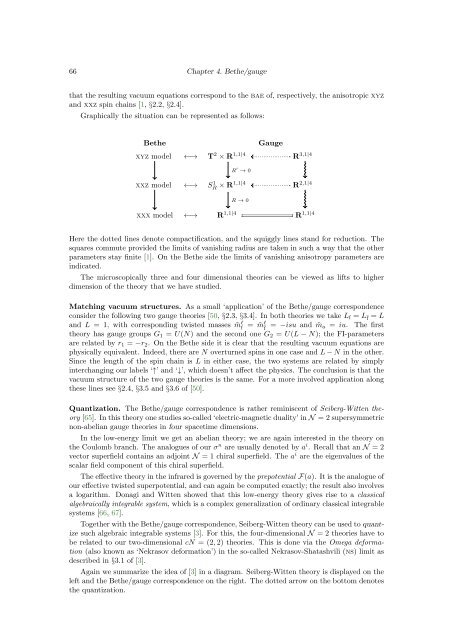The Bethe/Gauge Correspondence
The Bethe/Gauge Correspondence
The Bethe/Gauge Correspondence
You also want an ePaper? Increase the reach of your titles
YUMPU automatically turns print PDFs into web optimized ePapers that Google loves.
66 Chapter 4. <strong>Bethe</strong>/gaugethat the resulting vacuum equations correspond to the bae of, respectively, the anisotropic xyzand xxz spin chains [1, §2.2, §2.4].Graphically the situation can be represented as follows:<strong>Bethe</strong><strong>Gauge</strong>xyz model ←→ T 2 × R 1,1|4 R 3,1|4R ′ → 0xxz model ←→ S 1 R × R1,1|4 R 2,1|4R → 0xxx model ←→ R 1,1|4 R 1,1|4Here the dotted lines denote compactification, and the squiggly lines stand for reduction. <strong>The</strong>squares commute provided the limits of vanishing radius are taken in such a way that the otherparameters stay finite [1]. On the <strong>Bethe</strong> side the limits of vanishing anisotropy parameters areindicated.<strong>The</strong> microscopically three and four dimensional theories can be viewed as lifts to higherdimension of the theory that we have studied.Matching vacuum structures. As a small ‘application’ of the <strong>Bethe</strong>/gauge correspondenceconsider the following two gauge theories [50, §2.3, §3.4]. In both theories we take L f = L¯f = Land L = 1, with corresponding twisted masses ˜m l f= ˜m l¯f = −isu and ˜m a = iu. <strong>The</strong> firsttheory has gauge groups G 1 = U(N) and the second one G 2 = U(L − N); the FI-parametersare related by r 1 = −r 2 . On the <strong>Bethe</strong> side it is clear that the resulting vacuum equations arephysically equivalent. Indeed, there are N overturned spins in one case and L − N in the other.Since the length of the spin chain is L in either case, the two systems are related by simplyinterchanging our labels ‘↑’ and ‘↓’, which doesn’t affect the physics. <strong>The</strong> conclusion is that thevacuum structure of the two gauge theories is the same. For a more involved application alongthese lines see §2.4, §3.5 and §3.6 of [50].Quantization. <strong>The</strong> <strong>Bethe</strong>/gauge correspondence is rather reminiscent of Seiberg-Witten theory[65]. In this theory one studies so-called ‘electric-magnetic duality’ in N = 2 supersymmetricnon-abelian gauge theories in four spacetime dimensions.In the low-energy limit we get an abelian theory; we are again interested in the theory onthe Coulomb branch. <strong>The</strong> analogues of our σ n are usually denoted by a i . Recall that an N = 2vector superfield contains an adjoint N = 1 chiral superfield. <strong>The</strong> a i are the eigenvalues of thescalar field component of this chiral superfield.<strong>The</strong> effective theory in the infrared is governed by the prepotential F(a). It is the analogue ofour effective twisted superpotential, and can again be computed exactly; the result also involvesa logarithm. Donagi and Witten showed that this low-energy theory gives rise to a classicalalgebraically integrable system, which is a complex generalization of ordinary classical integrablesystems [66, 67].Together with the <strong>Bethe</strong>/gauge correspondence, Seiberg-Witten theory can be used to quantizesuch algebraic integrable systems [3]. For this, the four-dimensional N = 2 theories have tobe related to our two-dimensional cN = (2, 2) theories. This is done via the Omega deformation(also known as ‘Nekrasov deformation’) in the so-called Nekrasov-Shatashvili (ns) limit asdescribed in §3.1 of [3].Again we summarize the idea of [3] in a diagram. Seiberg-Witten theory is displayed on theleft and the <strong>Bethe</strong>/gauge correspondence on the right. <strong>The</strong> dotted arrow on the bottom denotesthe quantization.
















